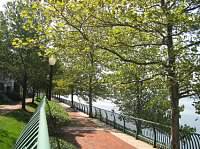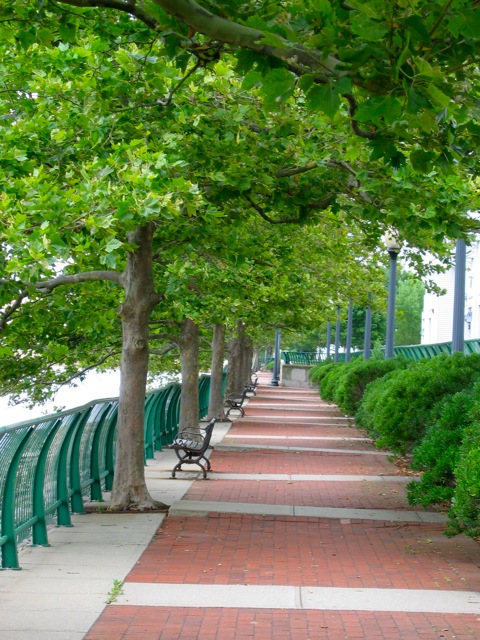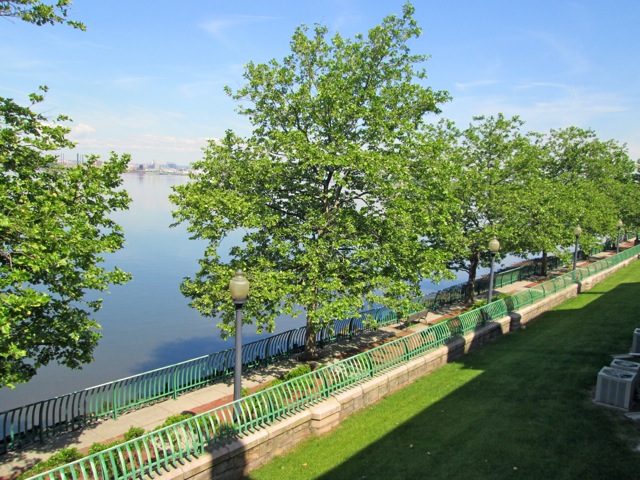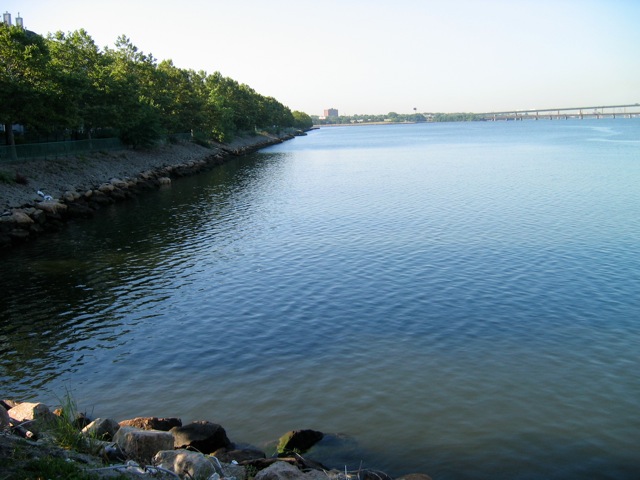Green Infrastructure
Street Trees | Rain Gardens | Green Roofs |
Street Trees | Rain Gardens | Green Roofs |
Sustainable JC’s Green Infrastructure initiative focuses on the idea of reducing flooding and the incidence of combined sewer overflow (CSO) events in our neighborhoods. It is an opportunity for improved ground-water infiltration to recharge underground aquifers and a reduction of pollution entering our surrounding rivers and even our streets.
Many people don’t know that the sewer system in Jersey City, referred to as a CSO system (Combined Sewer Overflow), works by combining both residential wastewater and stormwater underground to be treated in a shared facility. The system has a limited amount of capacity, which means during periods of heavy rainfall, when the system is overburdened, the excess overflow that breaches the capacity of our underground sewer system (raw sewage and all) is discharged into our local rivers, also sometimes backing up onto city streets.
Planning is underway to design a new system that captures more stormwater above ground with Green Infrastructure and new development projects capturing their property stormwater onsite, to prevent stormwater from entering the JC sewer system, thereby capping the number and volume of CSO overflows.
Green Infrastructure, in the form of street trees, rain gardens & bioswales, and green roofs/walls, will be an integral part of that plan by keeping stormwater out of the sewers in the first place.
Street Trees
Scope of the Problem
Look no further than the 2015 JCEC Sponsored Tree Canopy Study (satellite study) to learn more about why street trees are so important. According to that study back then, only 17% of the city was eco-serviced by trees! For cities our size, and in our geography, recommended tree canopy coverage is 25 - 35%. We are extremely deficient in our current tree inventory, with the new estimated JC Tree Canopy cover at only 10.9 (August 2020).
This 17% statistic does not reflect a walkabout assessment by JC Parks & Forestry completed during that period which determined that 20% of the trees in city parks were dead or dying. What that means, is that 17% statistic is really 13.6%. It is a credible idea, that the dead or dying trees statistic in parks is not limited to just parks, but applies across the city to street trees as well!
A 2015-2020 JC i-Tree Canopy Report shows JC tree canopy is now at 10.9%. If we deduct the 20% estimate of dead or dying trees in JC parks from the Parks & Forestry assessment back in 2015, then the 10.9% really becomes 8.7%.
In order to verify the 2015 SatelliteStudy, with an accurate tree inventory that would geolocate and map the existing trees and record species id, dimensions, their health status, etc., SJC partnered with Azevea in 2016 to create a JC OpenTreeMap (JC OTM). This is an open source mapping app used by major cities across the country. The app began hosting tree mapping meetups in 2015 to pilot the use of the tool and engage the community in a citizen science data collection effort for the city. Teams of volunteers took to the streets to map existing trees and get a better idea of where more trees need to be planted (we mapped empty Tree Pits!).
This was a very successful pilot and we learned a lot, mapping over 3,600 trees & empty tree pits through the fall of 2019. We then developed a report recommending we launch a city sponsored full scale tree mapping census campaign, training citizens as tree ambassadors to crowdsource inventory data.
Society Hill: A Cautionary Tale
In 2018, we continued to support protection of the Society Hill Shelterbelt of 84 mature trees on the Hackensack River Public Walkway. The Friends of the Walkway community group had been battling the DPWA association board there for 10 Years, and while the city of Jersey City had offered some directives, the city recently issued a single approval permit, without an independent assessment, to remove all 84 of those beautiful, healthy trees (a handful of these may have needed to be replaced due to their unstable condition). Previous directives from the city and guidance by independent tree advocacy orgs were to repair the walkway by lifting the large concrete slabs, replace those with small pavers around the base of the trees, and shave tree roots where needed. No enforcement took place and the city did not want to be bothered with oversight of doing the correct actions that were needed to save these trees. Citizens can get still get involved to express their outrage. See more info at the links below.
It's not only about just planting more trees, but protecting and maintaining the trees we do have. Chopping off tree canopies is continued in JC both by PSE&G and DPW/Parks & Forestry - why do we allow this? To help our existing trees thrive, more stewardship is needed. Compacted tree pits prevent trees from absorbing as much stormwater as they might otherwise, and we recommend a combination of compost and mulch to break up the compacted soil and re-invigorate the trees’ health.
Good stewardship begins at the beginning. In 2016, SJC and the NJ Tree Foundation co-hosted a Treekeepers Workshop (supported by Dickinson High School, JC DPW/Parks & Forestry and the JC Parks Coalition) teaching us the importance of planting "the right tree, in the right place, in the right way." Our Tree Stewardship activities have now taken on a life of its own with SJC being the lead urban forestry advocacy organization in Jersey City.
Tree Mapping
We can’t manage what we don’t measure! Let’s help our Jersey City forester by completing the historic Jersey City Mapping Census. We need more citizens to help us in mapping Jersey City’s street trees across the city!
Once you’ve signed up, here are some helpful links to get you started!
Rain Gardens & Bioswales
SJC's rain gardens + ART Campaign is an environmental remediation + educational outreach initiative. Rain gardens synthesize a stormwater capture and beautification strategy within a natural irrigation system for community gardens. This was demonstrated perfectly by the Washington Park Permaculture Learning Garden installation . By Rutgers' standards, 250,000 gallons of stormwater are diverted from Jersey City's sewer system each year as a result of this initiative!
Rain gardens SJC has installed in partnership with the NJ Tree Foundation:
2017: NJCU Campus Rain Garden In partnership with NJTF & funded by the Jersey City Municipal Utilities Authority.
2013: St. Paul’s Lutheran Rain Garden In partnership with NJTF & funded by the Dodge Foundation and crowdsourcing campaign.
It would be great to see more residences opt to convert lawns and hardscapes toward beautiful rain garden installations and smarter tree pit technologies. Check out the below example of a rain garden right in citizen Laurie Riccadonna’s front lawn!
What We Need
We need a city-wide rain garden campaign! Medium sized cities like ours have targeted 10,000 rain gardens for their campaigns. We think 11,000 is a good number for Jersey City!
Permaculture solutions and Green Infrastructure go hand in hand - SJC's Rain Garden + ART Campaign is modeled after this philosophy.
Further, the city of Jersey City received a Sustainable Jersey Award for an innovative demonstration project during their 2011 certification process, which was spearheaded by a citizen led initiative through the Washington Park Association (WPA). SJC's Rain Gardens + ART initiative, launched in 2011, is a citizen’s response initiative to the recent US EPA Consent Decree leveraged on Jersey City for violations of the Federal Clean Water Act. It is modeled after the successful WPA project, which included members of SJC’s founding leadership.
Advocacy Activities
-
These are the 2011 JCEC Recommendations for Municipal Action for Stormwater Management, yet to be implemented. Nor are the 2011 JC Sustainable Land Use Resolution commitments being adhered to…
-
SJC applauds the new NJ DEP Stormwater Management ruling to prioritize Green Infrastructure, including mandate for developers to prioritize Green Infrastructure in their projects pushing out best practices. Read more on the NJF Developers Guide For Green Infrastructure.
Also, Jersey City has amended its Stormwater Management Ordinance to align with NJ DEP Stormwater Management Rules, going further with GI guidelines for development/redevelopment for even smaller footprint properties located in designated flood zones (40% of Jersey City).
-
In partnership with outreach campaign ‘Sewage Free Streets & Rivers,’ SJC is advocating for more GI to be included as a priority in Jersey City’s Long Term Control Plan (LTCP)/JC MUA. We are looking for a higher percentage of GI in the mix of solutions. We’d also like to see an implementation plan with a schedule to front load this project, the largest capital improvements project in JC history. The project has already started with planned GI installations.
-
SJC has commented on the newly updated JC Master Plan (Land Use & Open Space Elements) asking to prioritize more GI including tree canopy restoration actions for Jeresy City. The update of the JC MP has implications for sync with the JC Resiliency Plan, which includes the GI Adaptation Management Plan.
-
SJC has successfully advocated to prioritize more street trees through our participation in the development of the JC Climate & Energy Action Plan, approved this past spring by City Council and this summer by the Planning Board (priority #8, under Buildings Energy Sector).
Green Roofs & Walls
In 2017, SJC partnered with developer JMA Architects Atelier to install the first green wall in Jersey City, a 30' high moss mural project located at 54 Bright Street. The project includes a moss mural with misting system. A moss mural like this one can purify the air as much as 275 trees. Special thanks to Amanda Levy and Joe Velez, the two artists who sourced and designed the project. This is another great example of an SJC + ART collaboration! See more photos below of this exciting first for SJC!
Additional Resources
Please find additional resources below, as well as on our Resources page, where you’ll see the list of related green ordinances and policy guidelines currently in place here under the heading of City of Jersey City Green (-ish) Policies. Unfortunately, there are many gaps and/or these are not being enforced and/or they are not being orchestrated in concert, This causes confusion and we do not achieve needed change in making Jersey City a more sustainable place to live and work.
-
-
For Developers: NJ Developers Green Infrastructure Guide
For Organizations: Sewage Free NJ, A Statewide Campaign
For Community Stakeholders: 5 Projects Any Community Can Do To Reduce Storm Water Runoff



























